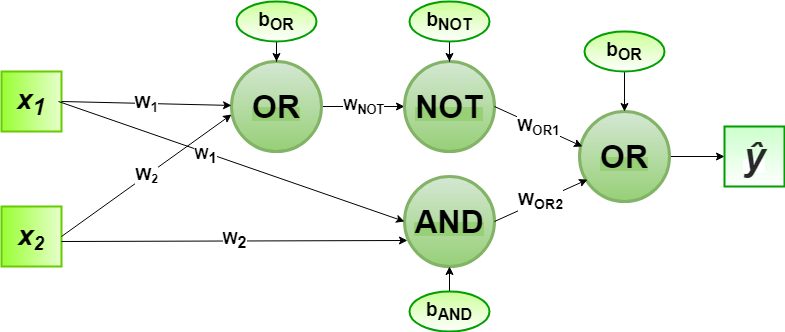2位二进制输入的XNOR逻辑门感知器算法的实现
在机器学习领域,感知器是一种用于二元分类器的监督学习算法。感知器模型实现以下函数:
![由 QuickLaTeX.com 渲染 \[ \begin{array}{c} \hat{y}=\Theta\left(w_{1} x_{1}+w_{2} x_{2}+\ldots+w_{n} x_{n}+b\right) \\ =\Theta(\mathbf{w} \cdot \mathbf{x}+b) \\ \text { where } \Theta(v)=\left\{\begin{array}{cc} 1 & \text { if } v \geqslant 0 \\ 0 & \text { otherwise } \end{array}\right. \end{array} \]](https://mangodoc.oss-cn-beijing.aliyuncs.com/geek8geeks/Implementation_of_Perceptron_Algorithm_for_XNOR_Logic_Gate_with_2-bit_Binary_Input_0.png)
对于权重向量的特定选择![]() 和偏置参数
和偏置参数![]() ,模型预测输出
,模型预测输出![]() 对于相应的输入向量
对于相应的输入向量![]() .
.
2位二进制变量的XNOR逻辑函数真值表,即输入向量![]() 和相应的输出
和相应的输出![]() –
–
| 0 | 0 | 1 |
| 0 | 1 | 0 |
| 1 | 0 | 0 |
| 1 | 1 | 1 |
我们可以观察到, ![]()
设计感知器网络:
- Step1:现在为对应的权重向量
 输入向量的
输入向量的 到 OR 和 AND 节点,相关的感知函数可以定义为:
到 OR 和 AND 节点,相关的感知函数可以定义为: ![由 QuickLaTeX.com 渲染 \[$\boldsymbol{\hat{y}_{1}} = \Theta\left(w_{1} x_{1}+w_{2} x_{2}+b_{OR}\right)$ \]](https://mangodoc.oss-cn-beijing.aliyuncs.com/geek8geeks/Implementation_of_Perceptron_Algorithm_for_XNOR_Logic_Gate_with_2-bit_Binary_Input_13.png)
![由 QuickLaTeX.com 渲染 \[$\boldsymbol{\hat{y}_{2}} = \Theta\left(w_{1} x_{1}+w_{2} x_{2}+b_{AND}\right)$ \]](https://mangodoc.oss-cn-beijing.aliyuncs.com/geek8geeks/Implementation_of_Perceptron_Algorithm_for_XNOR_Logic_Gate_with_2-bit_Binary_Input_14.png)
- 第二步:输出
 来自 OR 节点的将被输入到具有权重的 NOT 节点
来自 OR 节点的将被输入到具有权重的 NOT 节点 并且相关的感知函数可以定义为:
并且相关的感知函数可以定义为: ![由 QuickLaTeX.com 渲染 \[$\boldsymbol{\hat{y}_{3}} = \Theta\left(w_{NOT} \boldsymbol{\hat{y}_{1}}+b_{NOT}\right)$\]](https://mangodoc.oss-cn-beijing.aliyuncs.com/geek8geeks/Implementation_of_Perceptron_Algorithm_for_XNOR_Logic_Gate_with_2-bit_Binary_Input_17.png)
- 第三步:输出
 从 AND 节点和输出
从 AND 节点和输出 Step2中提到的来自NOT节点将被输入到具有权重的OR节点
Step2中提到的来自NOT节点将被输入到具有权重的OR节点 .然后对应的输出
.然后对应的输出 是 XNOR 逻辑函数的最终输出。相关的感知函数可以定义为:
是 XNOR 逻辑函数的最终输出。相关的感知函数可以定义为: ![由 QuickLaTeX.com 渲染 \[$\boldsymbol{\hat{y}} = \Theta\left(w_{OR1} \boldsymbol{\hat{y}_{3}}+w_{OR2} \boldsymbol{\hat{y}_{2}}+b_{OR}\right)$\]](https://mangodoc.oss-cn-beijing.aliyuncs.com/geek8geeks/Implementation_of_Perceptron_Algorithm_for_XNOR_Logic_Gate_with_2-bit_Binary_Input_22.png)

为了实现,权重参数被认为是![]() 和偏置参数是
和偏置参数是![]() .
.
Python实现:
# importing Python library
import numpy as np
# define Unit Step Function
def unitStep(v):
if v >= 0:
return 1
else:
return 0
# design Perceptron Model
def perceptronModel(x, w, b):
v = np.dot(w, x) + b
y = unitStep(v)
return y
# NOT Logic Function
# wNOT = -1, bNOT = 0.5
def NOT_logicFunction(x):
wNOT = -1
bNOT = 0.5
return perceptronModel(x, wNOT, bNOT)
# AND Logic Function
# w1 = 1, w2 = 1, bAND = -1.5
def AND_logicFunction(x):
w = np.array([1, 1])
bAND = -1.5
return perceptronModel(x, w, bAND)
# OR Logic Function
# here w1 = wOR1 = 1,
# w2 = wOR2 = 1, bOR = -0.5
def OR_logicFunction(x):
w = np.array([1, 1])
bOR = -0.5
return perceptronModel(x, w, bOR)
# XNOR Logic Function
# with AND, OR and NOT
# function calls in sequence
def XNOR_logicFunction(x):
y1 = OR_logicFunction(x)
y2 = AND_logicFunction(x)
y3 = NOT_logicFunction(y1)
final_x = np.array([y2, y3])
finalOutput = OR_logicFunction(final_x)
return finalOutput
# testing the Perceptron Model
test1 = np.array([0, 1])
test2 = np.array([1, 1])
test3 = np.array([0, 0])
test4 = np.array([1, 0])
print("XNOR({}, {}) = {}".format(0, 1, XNOR_logicFunction(test1)))
print("XNOR({}, {}) = {}".format(1, 1, XNOR_logicFunction(test2)))
print("XNOR({}, {}) = {}".format(0, 0, XNOR_logicFunction(test3)))
print("XNOR({}, {}) = {}".format(1, 0, XNOR_logicFunction(test4)))
输出:
XNOR(0, 1) = 0
XNOR(1, 1) = 1
XNOR(0, 0) = 1
XNOR(1, 0) = 0
这里,模型预测输出( ![]() ) 每个测试输入都与 XNOR 逻辑门常规输出 (
) 每个测试输入都与 XNOR 逻辑门常规输出 ( ![]() ) 根据真值表。
) 根据真值表。
因此,验证了 XNOR 逻辑门的感知器算法是正确实现的。